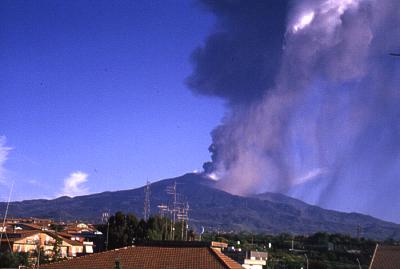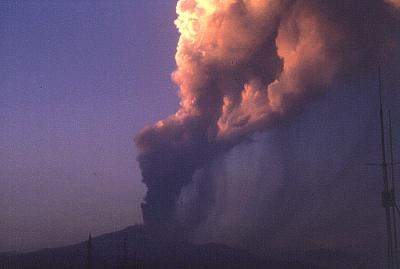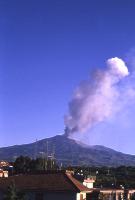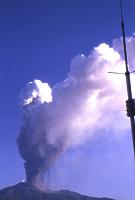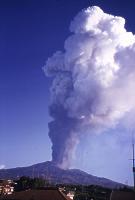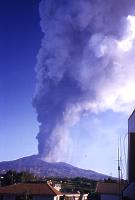|
WARNING:
Access to the summit area is VERY
DANGEROUS. Violent eruptive episodes are occurring
every few days at the Southeast Crater, and heavy showers of
tephra (including clasts tens of centimeters in diameter) may
occur up to several kilometers away. Lava may also arrive rapidly
at up to 1.5 km of distance from the crater on the plain between
Torre del Filosofo, Monte Frumento Supino, and the summit crater
cones. The Torre del Filosofo area, which is familiar to many
excursionists, is presently not a safe place at all. Tourists
are presently not allowed to go beyond 2700 m elevation,
and they should make excursions only with the mountain guides.
Besides this, weather conditions are often unstable. Strong
wind, snow or rain and clouds are occuring frequently in the
summit area, and one can get easily lost. The mountain guides
can be contacted at the cable car (near the Rifugio Sapienza)
on the southern side of Etna, or (during the summer) at the
hotel "Le Betulle" at Piano Provenzana, on the northern
side.
|
16 May 2000 update.
No forecast or prediction was made for an eruptive event that occurred
late in the evening of 15 May, only about 12 hours after the latest
paroxysmal eruptive episode from the SE Crater, and so Etna has once
more surprised many who are observing its activity.
Residents of towns around the volcano heard loud detonations at around
2315 h, and some were able to observe vigorous eruptive activity in
the summit area of Etna. While people watching this activity from
the S flank believed that the SE Crater was producing yet another
paroxysm, the view from the E sector proved that this time it was
the NE Crater that erupted. Ash falls this time affected the S sector
of the volcano, arriving as far as Catania, which lies some 25-30
km from the NE Crater. No details of the activity are available as
of the afternoon of 16 May, but it seems that there were lava fountains
and/or powerful Strombolian explosions. Strong gas emission from the
crater was observed on the morning of 16 May.
|
Photos
of the 26 April 2000 paroxysm:
The view from Sant'Agata li Battiati
These
photos are courtesy of Giovanni Sturiale
|
|
|
|
|
|
|
Eruptive
episode at the SE Crater on the morning of 26 April 2000, photographed
from the town of Sant'Agata li Battiati (to the N of Catania).
These four photos, taken at intervals of about 5 minutes at
the same angle, show the progressive growth of the eruption
column that rises from the crater, eventually reaching a height
of about 5 km above the summit of Etna. Note fallout to the
right of the column in last image. Shortly after this eruptive
episode an airplane encountered the plume while taking off from
the international airport of Catania, and had to return to the
airport. The pilot reported that the plume had not been visible
to him
|
|
Photos
of the 5 May 2000 paroxysm:
The view from Sant'Agata li Battiati
These
photos are courtesy of Giovanni Sturiale
|
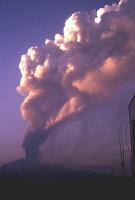 |
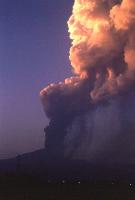 |
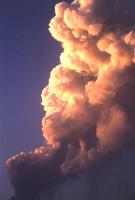 |
|
Eruptive
episode at the SE Crater on the evening of 5 May 2000, seen
from the home of Giovanni Sturiale in Sant'Agata li Battiati;
view is the same as in the 26 April 2000 photos above. The episode
occurred shortly after sunset, but the higher parts of the eruption
column are still illuminated by the setting sun.
|
15 May 2000 update (1900 h local time).
The forecast made in the previous update below (15 May 2000, 0235
h) has been fully correct. The 53rd paroxysmal eruptive episode from
the SE Crater occurred on 15 May between 1130 and 1200 h, after little
more than 12 hours of premonitory minor activity. Lava emission from
the N flank of the SE Crater cone appears to have begun at about 2300
h on 14 May, as observed by Giuseppe Scarpinati (Italian delegate
of the Paris-based Association Volcanologique Europeenne, L.A.V.E.)
from his home in Acireale. At about 0200 h on 15 May, Boris Behncke
(Dipartimento di Scienze Geologiche, University of Catania) observed
that a lava flow several hundred meters long had formed to the NE
of the SE Crater cone, but no explosive activity was seen at the source
of that flow, neither was there any activity visible at the summit
of the cone. The resumption of the activity was taken as evidence
that the crater had entered into the buildup phase of the next paroxysm,
which was expected to occur within the following 24 hours, most probably
before 1200 h on 15 May.
The crater did behave exactly as expected. At 1130 h, as Marco Fulle
(Stromboli On-line) and his wife Francesca were at about 2700 m elevation,
near the destroyed former upper cable car station on the S flank,
they heard the noise of the beginning paroxysmal phase of the activity.
Soon afterwards, the cloud cover that had previously prevented any
visibility in the summit area was torn open by a tremendous thermal
uprush, and the cone of the SE Crater became visible, ejecting an
intensely red lava fountain to hundreds of meters above the vent.
This activity lasted until about 1200 and then rapidly subsided, followed
by intense gas emission from the S flank of the cone. It is not known
whether there was any lava emission in that area.
According to Fulle, the tephra was probably blown to the SE, but he
noted that "there was very little wind". However, Giovanni
Sturiale (Dipartimento di Scienze Geologiche, University of Catania)
received a heavy shower of scoriaceous lapilli while staying in the
area of Fornazzo, on the ENE flank of Etna. The southern margin of
the fallout sector passed to the S of that village, which means that
the most affected area is probably the NE flank.
The SE Crater will now fall back into a state of complete inactivity,
which may last 9-10 days. If the crater continues to behave as regularly
as it has done since early April, then the next paroxysmal eruptive
episode will be preceded by minor eruptive activity, probably in the
form of lava extrusion from the N flank. The beginning of this activity
will be followed after about 12-18 hours by a phase of violent lava
fountaining and tephra emission, and probably also by lava emission
on the N or S flank of its cone, or both.
Although this latest eruptive episode repeated in all details its
predecessors, something was different this time in Etna's summit area.
The SE Crater was not the only crater to erupt in the past 24 hours.
When Scarpinati observed the summit area on the late evening of 14
May, he saw "quite intense" Strombolian activity from a
location which clearly lay to the N of the source of the lava flow
of the SE Crater, probably at the NE Crater. This crater had shown
signs of increasing activity in the past two weeks. On 14 May, Sturiale,
who was on the NE flank of the volcano, observed frequent emissions
of dense, ash-laden plumes from the crater. Shortly before noon on
15 May, Sturiale was near the village of Fornazzo on the ENE flank
of Etna and observed vigorous ash emission from the NE Crater - this
was at the same time when the SE Crater produced the paroxysm. Sturiale
could not see the SE Crater, which was hidden behind weather clouds,
but the NE Crater was visible; the noise of the lava jetting at the
SE Crater was well audible, so that he thought the NE Crater had entered
into a paroxysmal episode.
The NE Crater, which was the most active vent at Etna's summit for
most of the 20th century but became less active after the early 1980's,
was last active in September-October 1999, when it produced near continuous
Strombolian bursts during a period of about 3 weeks. In September
1986 the crater produced one of the most violent eruptive episodes
observed on Etna in recent decades.
15
May 2000 update (02:35 h local time).
Lava is flowing from the N flank of the SE Crater since the late evening
of 14 May. The new lava flow was first seen by Giuseppe Scarpinati
from Acireale somtime around 2300 h, along with Strombolian activity
from a site that was distinctly to the N of the SE Crater (maybe the
NE Crater?). The effusive activity was seen to be significantly more
vigorous at 0200 h by Boris Behncke, while driving from Acireale to
Catania.
The resumption of effusive activity from vents on the fracture cutting
from N to S across the SE Crater is an almost certain indicator that
a new paroxysmal eruptive episode will occur within less than 24 hours,
probably before noon on 15 May. The SE Crater thus remains extremely
faithful to its very regular eruptive behavior in the past six weeks.
The Strombolian activity seen by Scarpinati to the N of the SE Crater
and its active lava flow cannot be well understood at this moment,
but more information will be posted as soon as it becomes available.
13
May 2000 update.
The SE Crater has remained quiet for the eigth consecutive day after
its latest paroxysmal eruptive episode on 5 May. This was to be expected,
since the repose intervals between such events have been very regular
in the past month, varying from 9.5 to 10 days. If the crater maintains
this regular behavior, the next eruptive episode - the 53rd in less
than four months - can be expected to occur on 14 or 15 May. An interesting
question is whether the current repose interval will follow the observed
trend of a very gradual shortening of these quiet intervals.
On the late forenoon of 13 May, very minor gas emission was seen somewhere
on the lower S flank of the SE Crater cone, but observations were
rendered difficult by bad weather conditions. If there is really gas
emission from that area - maybe the Sudestino cone at the S base of
the cone - this may be taken as an almost certain indicator that the
crater is beginning to reactivate, and this will very likely lead
to the expected next paroxysmal episode. The next few days will show
if these assumptions are realistic.
There has been a light snow fall in the summit area of Etna on 13
May. Different from the past three years, the summer is not beginning
as abruptly in Sicily in this year; there is actually a spring season,
which in the past few years had been omitted. Yet the temperature
has been rising rapidly in Catania since 12 May, but still the weather
conditions are unstable, creating some difficulty for many people
who are on "eruption watch" at Etna, hoping to catch the
next paroxysm...
Note: You may now watch some very impressive movie clips
(avi format) of the 5 May paroxysm that have been posted on the Etna
web site of Charles Rivière who witnessed the event from
Torre del Filosofo. The most up-to-date section of the site is in
French. The movies are also available (as Quicktime files) at Stromboli
On-line.
8
May 2000 update.
A state of relative quiet has prevailed at Etna's summit craters since
the latest paroxysm at the SE Crater on 5 May. Yet that area has not
been totally silent. On 6-7 May, there were frequent emissions of
ash from the NE Crater, which had last shown significant activity
in the first half of October 1999. These new signs of activity were
possibly related to the sliding of material from the crater walls
into the deeper parts of its conduit, which is steadily degassing.
While the emissions continued to the early afternoon of 7 May, none
have been noted since. It has to be noted that similar emissions occurred
sporadically in the summer of 1999, heralding the gradual reactivation
of the summit craters that culminated in the spectacular eruptions
of September-November 1999.
At the same time, the Bocca Nuova has become much more busy in producing
gas rings. On the late afternoon of 7 May, Behncke and others, while
resting at the Rifugio Citelli on the NE flank of Etna observed the
emission of five gas rings within about one minute; hundreds of such
rings were produced throughout the day.
This slight increase in the activity was interpreted by Robert Clocchiatti
and Charles Rivière as a response to changes in the magmatic
pressure regime in the central conduit system of the volcano as a
result of the violent eruptive episode at the SE Crater on 5 May.
This paroxysm was described as even more violent than that of 16 April
(based on comparison of video footage of both events by the mountain
guide Antonio Nicoloso and Charles Rivière). It seems that
some bombs fell again at the Torre del Filosofo (Rivière had
to seek shelter under the protective roof on the SE side of the building),
but most bombs fell to the SE of the crater, and heavy tephra fall
occurred also at the "Belvedere" lookout on the rim of the
Valle del Bove, about 2 km SE of the crater, which is the point where
guided tourist tours terminate in these days.
In the meantime several towns and villages on the E and SE sides of
the volcano have to cope with the lapilli and ash that have fallen
during the recent paroxysms of the SE Crater. The town of Zafferana,
one of the most stricken, is under a state of calamity since 1 March,
and has asked financial and technical aid from the regional and national
governments; in the past few months the town has received nine showers
of tephra from the SE Crater eruptions. Even towns lying at greater
distance from the summit have to struggle with the fallout. After
the 5 May paroxysm, Giuseppe Scarpinati had to remove 100 kilograms
of lapilli from his terrace in Acireale, which he had just cleaned
from the lapilli of the previous paroxysm of 26 April.
It seems that people living near Etna - especially in the sector encompassing
the NE, E and SE sides of the volcano - have to face a long period
of ongoing pyroclastic eruptions from the summit craters, and more
tephra falls are to be expected. As a rule, summit eruptions at Etna
are more explosive than flank eruptions, and in the past 5 years,
summit eruptions have been near continuous. In contrast to earlier
periods of long-lasting summit activity, the eruptions in the past
5 years have been more intense and had more frequent episodes of paroxysmal
activity. It is not known how long this exceptional summit activity
will continue (and many hope that it will continue, in spite of the
tephra falls, because once they will end, they will do so because
there will be flank activity), but it is possible that it will do
so for some years to come.
6
May 2000 update.
Just as this update is posted, at dusk on 6 May, dark gray emissions
(ash?) have appeared at the NE Crater (no typo, this is the North-east
Crater). These emissions are visible from Acireale (information from
Giuseppe Scarpinati), and a diffuse plume is drifting towards SE.
The activity is definitely not coming from the SE Crater, which has
returned to its intereruptive state of quiescence. In the meantime
information has emerged about an incident related to the latest eruptive
episode at the SE Crater on 5 May.
The 6 May edition of the local newspaper "La Sicilia", reporting
on the event, tells the dramatic story of a German tourist who remained
in the summit area to see the eruptive activity and was later reported
missing by his daughter, who had descended earlier from the mountain.
The man had not returned when it got dark, while the activity culminated
in the paroxysm, and a search operation was launched by the Alpine
rescue corps on the upper S flank of the volcano. The search was rendered
difficult by falling tephra, weather clouds and increasing darkness.
Finally the man was found while descending on the track towards Piano
Provenzana, on the N flank of the mountain.
This incident casts new light on an old problem which has been discussed
repeatedly on this page in the past two years or so, and which is
also addressed in the box above. In spite of the warning signs exposed
at the cable car stations and elsewhere along the roads towards the
summit area, many tourists (and lots of them unexperienced) venture
to "see the lava" and enter zones of high risk. During the
past months it has repeatedly happened to the author of this site
that excursionists expressed to him their intention to climb on the
cone of the SE Crater, simply not knowing anything about the potential
danger, and they could be kept from doing so only after long and insistent
explanations. Two young men from Germany had been on the rim of the
crater in early 1998 when this was still a fairly harmless affair;
at that time there was continuous mild Strombolian activity occurring
at a small cone on the crater floor. They believed this was still
possible, not realizing that the cone had in the meantime grown by
about 100 m and become much steeper (and thus much more difficult
to climb), and they did not know that the kind of activity they had
witnessed had been replaced by violent paroxysms. On another occasion,
during a period of strong explosive activity at the summit craters
in September 1999, two people were seen walking on the rim of the
Bocca Nuova in spite of dense weather clouds, which would have prevented
them from seeing any rock fragments flying towards them.
Fortunately no serious accident caused by the eruptive activity has
occurred so far, but with a steadily growing influx of tourists -
of which many are absolutely not prepared for the meteorological and
eruptive conditions prevailing at Etna's summit - it seems only a
question of time that something bad will happen up there. To render
things more complex, much of the area around the summit craters has
been covered by fresh lava (the dirt road that once connected the
S and N flanks has been buried along two sections, each about 1 km
long, by lava flows produced during the October-November 1999 activity
at the Bocca Nuova, and since March 2000 at the SE Crater, and the
section between these lavas is covered by tens of centimeters of fresh
scoriae). These lava fields are extremely difficult to walk on, since
they have very chaotic surfaces, with very spiny slabs of lava and
unstably placed blocks. In the case of a strong eruption escape across
this material will be a painful and very slow process.
The aforementioned newspaper report in "La Sicilia" wrongly
states that the eruptive episode came from the NE Crater (it really
came from the SE Crater) and reports tephra falls at Acireale, Acicastello
and Acitrezza. While the latter two towns had been affected by heavy
tephra falls during the previous paroxysmal episode on 26 April, they
have been spared on 5 May; as reported in the previous update (see
below), the southern margin of the tephra fall sector passed across
the town of Acireale, to the north of the two smaller towns.
Like its predecessors, this latest eruptive episode was preceded by
many hours of minor activity. Charles Rivière reports that
mild Strombolian explosions began from the summit vent of the SE Crater
during the early forenoon of 5 May, about 12 hours before the main
paroxysmal phase. It is thus fully true that these paroxysmal eruptive
episodes can be foreseen quite well, since in all recent cases such
premonitory activity has unvariably led to a paroxysm within a time
frame of 12-18 hours. This has significant implications for timely
warnings to tourists, authorities of the sectors most likely to be
affected by tephra falls, and the control center at the international
airport of Catania. Yet it seems that communication does not work
as it should, and there is a strong need for an improved system of
timely advice as similar activity is likely to continue for some time
at the SE Crater.
Note: Very spectacular photos
(captured from video footage) of the 5 May paroxysm are now available
on the Etna
web site of Charles Rivière who witnessed the event from
Torre del Filosofo. The most up-to-date section of the site is in
French.
5
May 2000 update.
The 52nd paroxysmal eruptive episode from the SE Crater since 6 January
occurred on the late afternoon/early evening of 5 May, after nine
and a half days of absolute quiet. This event was observed under somewhat
difficult conditions by Boris Behncke (Dipartimento di Scienze Geologiche,
University of Catania) and Giuseppe Scarpinati (Italian delegate of
the Paris-based Association Volcanologique Europeenne, L.A.V.E.),
who then mapped the approximate area of tephra fall when freshly fallen,
during their return from the volcano.
No signs of eruptive activity were observed during the night of 4-5
May from Acireale (information from Scarpinati). During the early
afternoon, Behncke and Scarpinati drove to the volcano for an excursion
from the "Piano del Vescovo" (a small plain that lies on
the SE flank above the town of Zafferana) to the S rim of the Valle
del Bove (Serra del Solfizio) along the deeply incised Vallone Acqua
Rocca. During their ascent, frequent loud explosion noises were heard
from the summit area, and it soon became apparent that these were
not coming from the Bocca Nuova. From the crest of the Serra del Solfizio,
Behncke and Scarpinati descended onto the floor of the Valle del Bove
and then walked about 1 km upslope along the base of the S rim of
the Valle. During this part of the excursion, which lasted about 1.5
hours, the sounds of the eruptive activity became progressively louder
and more frequent. A bank of clouds hovered below the summit area,
covering it for most of the time, but during occasional breaks in
the clouds, the SE Crater became briefly visible, and surprisingly
no visible signs of eruptive activity could be made out.
This changed at about 1800 h, when Behncke and Scarpinati had climbed
back on the Serra del Solfizio and the clouds had largely disappeared.
By this time strong gas emission from the N flank of the SE Crater
cone and a line of rising fume to the NE indicated effusive activity
at that site; yet no jets of incandescent material or flowing lava
were visible. It remained thus a mystery where the explosions which
made the noise took place. The Sudestino cone at the S base of the
SE Crater cone was plainly visible and did not show any activity.
Sometime after 1800 h, small, dark eruption plumes began to rise from
the summit of the SE Crater cone at intervals of several minutes.
During the following hour the amount of gas rising from the area of
the SE Crater increased notably, and by 1900 h it became clear that
the plume would drift right in the direction of the place where Behncke
and Scarpinati were observing the activity, thus they decided to descend
along the Vallone Acqua Rocca to get to the car and escape from the
expected fallout. For about 15 minutes the discrete, loud explosion
sounds generated by Strombolian activity continued, but then the noise
suddenly disappeared, followed almost immediately by the rise of a
much denser plume. Shortly before 1930 h Behncke and Scarpinati arrived
at the outlet of the Vallone Acqua Rocca near Piano del Vescovo, and
looking back up towards the summit area, they noted that a black eruption
column began to rise rapidly into the sky above them. A slight rain
of ash had already begun a few minutes earlier; on the last 300 m
of the path towards the car, scoria fragments up to 3 cm in diameter
began to fall around them. When leaving Piano del Vescovo in the car,
a heavy downpour of scoriae with diameters of max. 5 cm began.
Racing towards the area of the Rifugio Sapienza to the W, they eventually
left the fallout area, but before that they saw scoria lumps as large
as 10 cm crash onto the pavement of the road and bursting into smaller
fragments. None of these fragments were incandescent. During the drive
up to the Rifugio Sapienza, intense tephra emission and lava fountaining
continued from the SE Crater, and the eruption column rose several
kilometers high, its white upper portion being spectacularly illuminated
by the setting sun. This was accompanied by a deep roaring noise that
could be heard above the motor of the car. When Behncke and Scarpinati
arrived at Monte Vetore, to the SW of the Rifugio Sapienza, the paroxysmal
phase of the activity began to decline, and lava fountaining and tephra
emission ended by about 2000 h.
When driving back via Zafferana towards Acireale, Behncke and Scarpinati
had to go across the area of tephra fallout, crossing various times
its northern and southern limits, so that a fairly clear idea of the
sector stricken by the ash and scoria fall could be obtained. The
northern limit of this sector passes through Zafferana and the village
of Santa Venerina, extending to the coast of the Ionian sea near the
village of Mangano, whereas its southern limit runs across the village
of Monterosso towards Acireale whose northern part received ash and
small lapilli, while only traces of ash fell in the southern part
of the town. In Poggiofelice and Fleri to the S of Zafferana the fall
deposit was continuous, creating traffic problems.
Furthermore it could be observed that lava flows had extended from
the vents on the lower N flank of the SE Crater cone towards NE, in
the direction of the Valle del Leone. A longer, less brightly incandescent
flow had reached a length of 0.5-1 km, while a fresher flow extended
about 200 m further to the S.
In the past four weeks the repose intervals between the most recent
four eruptive episodes have been remarkably regular. Exactly ten days
passed between those of 6 and 16 April, while that of 26 April came
after 9 days and 19 hours; the latest repose interval lasted 9 days
and almost 12 hours. Three of the latest four paroxysms were relatively
short, with their main phases lasting approximately 30 minutes in
each case; the 16 April paroxysm had several phases of vigorous activity
but its culminating phase lasted 25 minutes. The SE Crater has thus
established a fairly regular behavior, even though it is likely that
it will not maintain this same rhythm for long.
No eruptive activity has occurred at the other summit craters, except
the regular gas bursts from the E vent of the Bocca Nuova, which continue
to provide the unusual spectacle of gas rings (one of these rings
was seen travelling across the growing eruption column of the SE Crater
paroxysm on 5 May).
Several
other web pages covering the recent and ongoing eruptions of the Southeast
Crater are now available; these contain photos and movie clips of
some of the most spectacular moments of that period.
Etna
in 2000 - a list of all paroxysms at the SE Crater since 26 January
and photos (this site)
Extremely
spectacular video clips, taken by British cameraman and film maker
David Bryant on 15 February 2000
At
"Italy's Volcanoes" -
At Stromboli On-line
An
interview with Boris Behncke, made in late February 2000 by a BBC
team
and a video
clip (RealPlayer)
Photos
of the eruptive activity, 15-23 February 2000, by Tom Pfeiffer (University
of Arhus, Denmark)
Photos
of an eruptive episode on 13 February 2000, posted on the web site
of the Association Volcanologique Européenne, Paris, France
Photos
of the 15 February 2000 paroxysm of the SE Crater, by Thorsten Boeckel,
Germany
Photos
by Marco Fulle, 15-20 February 2000, at Stromboli On-line - very high
quality, as usual
Charles
Rivière's Etna home page, with many photos and video clips
(the most recent of the paroxysm of 5 May 2000), updates, and other,
highly interesting items (in French and English)

